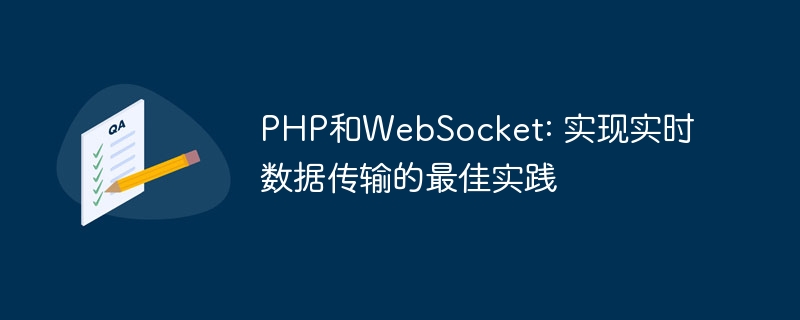Home >Backend Development >PHP Tutorial >PHP and WebSocket: Best practices for real-time data transfer
PHP and WebSocket: Best practices for real-time data transfer
- WBOYWBOYWBOYWBOYWBOYWBOYWBOYWBOYWBOYWBOYWBOYWBOYWBOriginal
- 2023-12-17 21:21:33749browse

In recent years, with the rapid development of the Internet, the demand for real-time communication has become stronger and stronger, and the emergence of WebSocket provides a more elegant solution for real-time data transmission. In web development, the PHP language also occupies a place among the mainstream back-end languages. So, how to use PHP and WebSocket to achieve real-time data transmission?
1. What is WebSocket
WebSocket is a full-duplex communication protocol that communicates through port 80 or 443 of the HTTP/HTTPS protocol. When WebSocket establishes a connection, both the client and the server can send messages to each other without the need for a "request-response" mode. Therefore, it has the advantages of strong real-time performance, two-way communication, and low overhead, and is suitable for real-time chat. , online games and other scenarios that require fast interaction.
2. Using WebSocket in PHP
Commonly used PHP frameworks in Web development include Laravel, CodeIgniter, etc. The following will take Laravel as an example to introduce how to use PHP and WebSocket to achieve real-time data transmission.
- Installing Ratchet
Ratchet is a WebSocket library for PHP that can be used to implement the WebSocket server. In the Laravel project, it can be installed through composer. The command is as follows:
$ composer require cboden/ratchet
- Create WebSocket controller
Create WebSocket in the app/Http/Controllers directory of the Laravel project Controller, named ChatController. This controller inherits Ratchet's MessageComponentInterface interface and overrides its onOpen, onMessage, onClose, and onError methods, as shown below:
<?php
namespace AppHttpControllers;
use RatchetMessageComponentInterface;
use RatchetConnectionInterface;
class ChatController implements MessageComponentInterface
{
protected $clients;
public function __construct()
{
$this->clients = new SplObjectStorage;
}
public function onOpen(ConnectionInterface $conn)
{
$this->clients->attach($conn);
echo "New connection! ({$conn->resourceId})
";
}
public function onMessage(ConnectionInterface $from, $msg)
{
foreach ($this->clients as $client) {
if ($from != $client) {
$client->send($msg);
}
}
}
public function onClose(ConnectionInterface $conn)
{
$this->clients->detach($conn);
echo "Connection {$conn->resourceId} has disconnected
";
}
public function onError(ConnectionInterface $conn, Exception $e)
{
echo "An error has occurred: {$e->getMessage()}
";
$conn->close();
}
}In this controller, $clients is a collection of client connection objects , the onOpen method represents the callback method when a new client connects, the onMessage method represents the callback method when a client message is received, the onClose method represents the callback method when the client disconnects, and the onError method represents the callback method when a connection error occurs. .
- Create WebSocket service
Add the following code in the routes/web.php routing file of the Laravel project:
use RatchetHttpHttpServer;
use RatchetWebSocketWsServer;
use AppHttpControllersChatController;
Route::get('/chat', function () {
$server = IoServer::factory(
new HttpServer(
new WsServer(
new ChatController()
)
),
8080
);
$server->run();
});This code indicates that a WebSocket service listens to the local port 8080, and the controller corresponding to the service is ChatController.
- Client code
In the front-end page, the connection to the WebSocket service can be established through JavaScript code, as shown below:
var conn = new WebSocket('ws://localhost:8080');
conn.onopen = function (e) {
console.log("Connection established!");
};
conn.onmessage = function (e) {
console.log("Received: " + e.data);
};
conn.onclose = function (e) {
console.log("Connection closed!");
};
conn.onerror = function (e) {
console.log("Error occurred: " + e.data);
};
function sendMessage() {
var input = document.getElementById("messageInput");
conn.send(input.value);
input.value = "";
}The code Indicates that the connection between WebSocket and the server has been established. When the server message is received, it is output to the console. When sending the message, the send method is called.
- Test
After starting the Laravel project, visit http://localhost/chat in the browser to establish a connection with the server through WebSocket to achieve real-time data transmission.
The above is a code example for using PHP and WebSocket to realize real-time data transmission. It can be developed in more detail according to actual needs to improve the real-time performance and performance of the application.
The above is the detailed content of PHP and WebSocket: Best practices for real-time data transfer. For more information, please follow other related articles on the PHP Chinese website!

